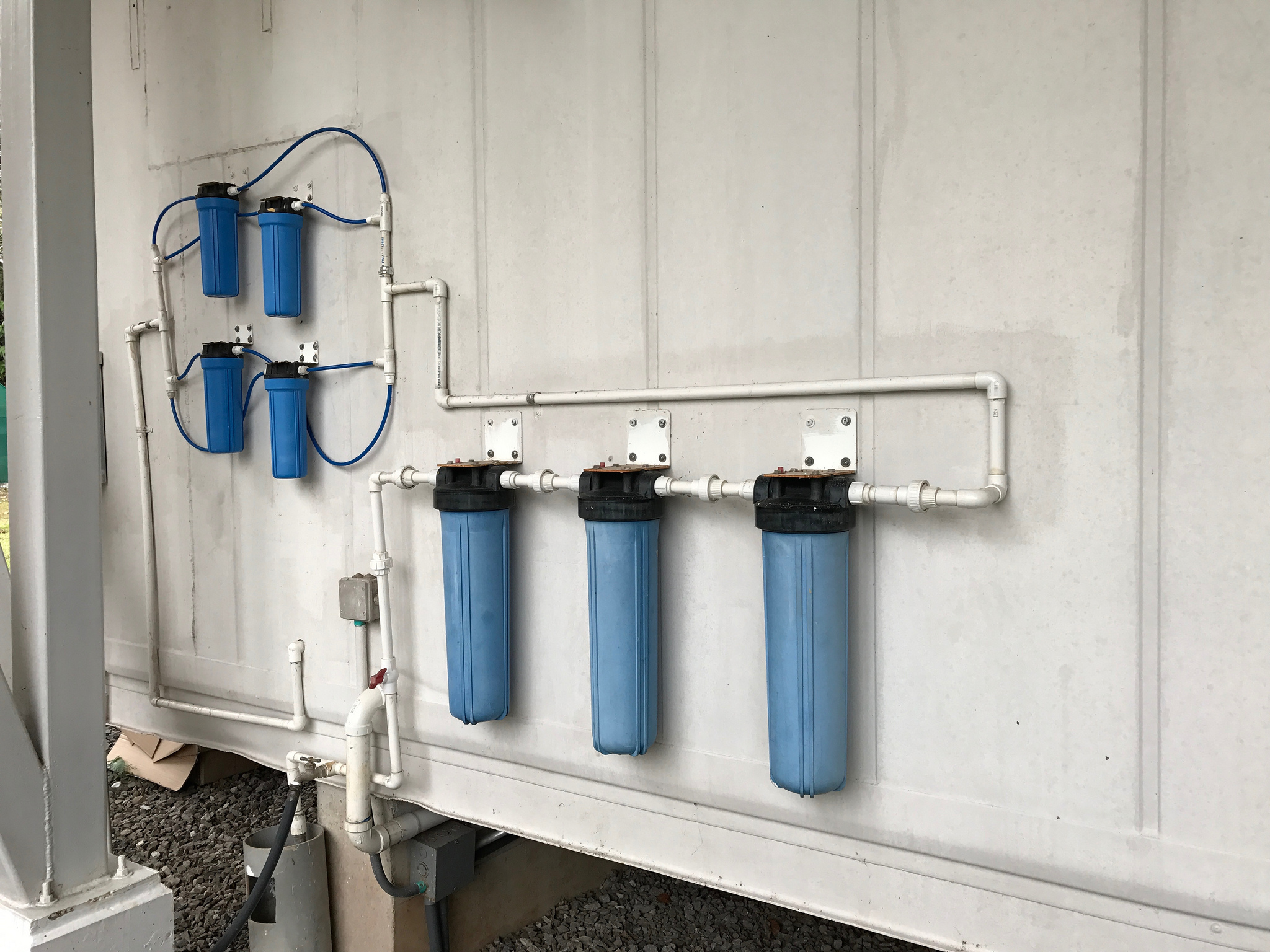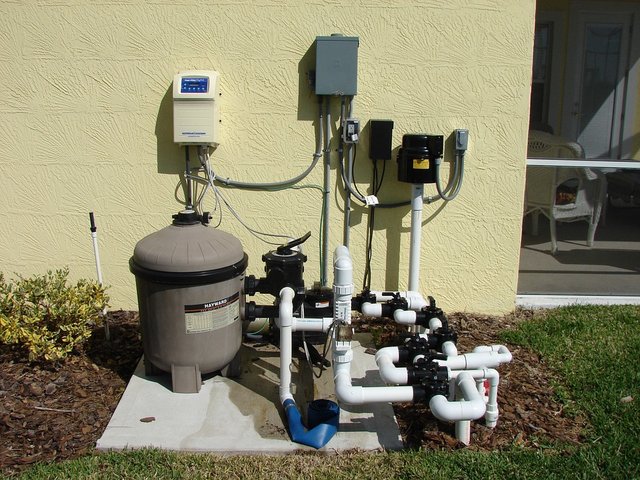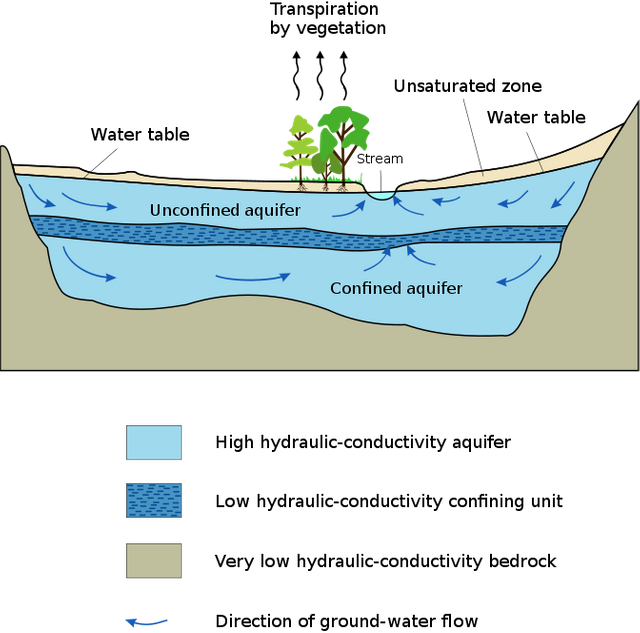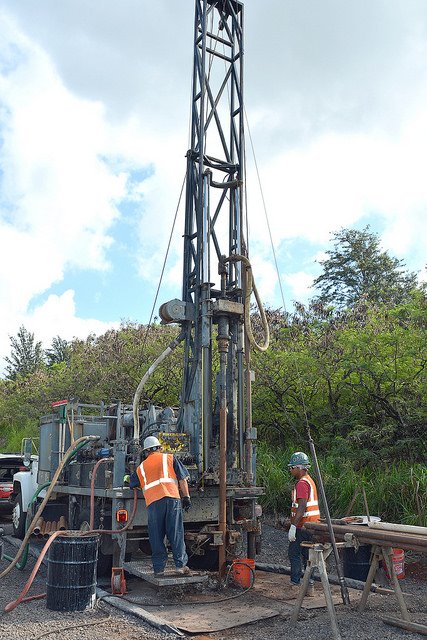How to: Off-Grid House - Water and Sewage
Living in an off-the-grid house doesn't mean that you have to compromise on comfort.
When I first thought about buying a house (remember, I was 20 at the time), I had the preconception of having to live like I saw in the rural areas of the country, with a well and toilet outside of the house. I knew that there were some improvements but I had no idea how that would be possible. So I have studied the housing and the market for land properties, soon it made no sense to even think of buying a house which was connected to the services. This was mainly because of the price. So I have devised a SWOT to find out if it was worth it. (find out what this is from a fellow Steemian). Then, after I was educated on the advantages and disadvantages, I could go further with the plan.

What are the needs of the house and what can be provided off the grid?
First of all you need water, most can be dirty, a part must be clean and a small amount must be potable. Throughout this article, I will use as a basis of calculation the needs of a small family: Two adults and two children but you can calculate your own needs using my ideas. I have actually devised my own - unofficial :) - unit of measure (the minuteFaucet) since I have chosen a faucet that allows a predefined amount of water to pass through, which is 10 Liters per minute. I will get to this later.
The average daily water consumption stands like this:
| Reason | Purity | Time |
|---|---|---|
| Irrigation | unfiltered | 30 min |
| Car wash | unfiltered | 5 min |
| House water | filtered | 90 min |
| Drinking water | pure | 2 min |
Basically, most of the consumption comes from either irrigation which is dependent on the size of the land owned and the house water which consists of two showers per day, water to wash dishes using a dishwasher and water for the washing machine. If both of those machines are highly efficient, then the consumption is negligible.
Presuming that everything will run at once, we can calculate that the peak consumption would be around 40-50 liters per minute and a total consumption of 1300 Liters (343 Gallons).

Getting your own water
The basic way to get water on Earth is to drill for it, presuming you don't have a waterfront property or you are not building your house on the floodplains, which is something I don't advise due to water coming in through the windows and doors and not from a faucet :D
There is a website which centralizes all of the satellite data for the aquifer depth and resources so be sure to check it before embarking on the journey of drilling. The drilling company also has access to local aquifer data and can even make some suggestions.
Drilling for water is a simple process but can vary in cost depending on the materials used and the depth of the borehole. If you live in a residential area which has never had another source of water than from a borehole, than I can advise you to drill to the second aquifer. The first one is probably compromised by other drilling or accidental spills.
An aquifer is a layer of water-permeable rocks that traps groundwater. Sometimes rock layers break or are pushed outward and they break forming streams and springs, but under the first aquifer there are more layers of subsequent rocks and water, which are not exposed to the same factors. Drilling to the second or third aquifer is thus a good way to minimize pollutants and reach cleaner water. Also drilling to an aquifer that is not tapped by others means that in case of extreme drought you will still have access to clean and plentiful water.

Drilling process
Modern drilling is automatized and usually very fast. It consists of a pneumatic drill in the back of a truck. It digs into the ground and a layer of sand and gravel is deposited on the outside of the big drill, then a filter tube is lowered into the hole, usually sections are being added while the hole is being drilled. I won't go into many details about the process, although it's very interesting to see and analyze. The tube is PVC and the filter is built into the tube, thus making sure that the water is not contaminated by the other aquifers.
A pump is lowered into the newly created well and will pump all the mud and impurities out, until the water becomes clear. Then the final pump is lowered and it can be included in an automated system to provide water for the house. The diameters of the well should also be taken into account as it doesn't have to be too wide for the selected pump, maintaining the cost low but it shouldn't be too narrow as to limit the selection of pumps. The pumps can be single level or multi level, depending on the depth of the well.

Piping
The piping of the house can be made of Polypropylene Random Copolymer or PPR . They are hard pipes made of very resistant polymers. Some have aluminium inserts (the ones for hot water) or can be made with extra fibers addition (colored green). It has many advantages over metal piping (galvanized iron or other cheap allows). There are better iron alloys but they are much more expensive than PPR so we are only going to analyze the best quality for the price:
- PPR is much more lightweight than metal piping.
- PPR has a much smoother internal surface.
- PPR pipes are not susceptible to corrosion.
- PPR pipes are connected by melting the ends and bonding them to one another. No leaking and no other sealing material, solid or liquid needs to be present on the threading.
- PPR pipes are flexible, which means that torsion and curving is tolerated and even encouraged, since it will reduce the number of straight angle fittings which usually reduce flow.
- The prices of PPR are usually lower than metal counterparts.

Filters
As I have said before, in order to be economical and keep the energy consumption low, you can use unfiltered water for usual needs like watering the greenery or garden or washing the car. For the other activities like washing (yourself, dishes or clothes) or drinking, you should use filters. What kind of filters would you need and how to find out. A basic set of filters is not expensive, so you could just buy them all, but for the most advanced needs or if you plan on drinking the water then you should do a microbiological test. It doesn't cost a lot (30$) and you get the specs of your drinking water, they might even recommend what filters to use.
Among the basic filters you would need: These filters are very cheap and can be replaced without much problem by any user. Additional filters might be used for further reducing the limescale of the water and to prevent limescale deposits on the appliances and bathroom fixtures. The water analysis made by a lab might highlight the existence of hard water. This is usually occurring in areas of high mineral deposits. When the aquifers pass through a layer of calcium or magnesium the water washes off the deposits and gains calcium ions. A water softener usually uses ion exchanging resin to isolate and dismiss those calcium ions. The resulting water is softened by an amount or fully and the systems can even control the hours of operation. This is a more expensive system, it need physical sodium tablets recharges and once every few years, the replenishment of the ion-exchange resin. While this system needs a technical room and can get quite bulky (the size or a single door locker), its benefits can easily overwhelm the disadvantages. The type of water softener I use has a smart control valve that auto regulated the quantity of resin and the quantity of sodium tablets it uses, so everything is done without my supervision. The hours of resin regeneration (once a week) is planned late on Monday nights, right before dawn, and it takes the system out of commission for 20 minutes. If water is needed in this time, a valve is automatically triggered and it bypasses the system. The final level of treatment is the use of UV lamps or inverse osmosis to make potable water. The prices vary depending on the quantities of pure water sought and can vary from 50$ (strictly for daily drinking water and water to use in food) to $1000+ for the ultraviolet light. In the case of a small inverse osmosis system, a semipermeable membrane is used to filter impurities from the water. Sometimes though, this membrane actually also filters minerals that the body expects to find in the drinking water so having another source of those elements is considered useful. Some suppliers also offer remineralization tablets, but I don't know how much of it is marketing and how much is actual science. In the case of the UV lamps, a transparent glass coil is wrapped around a powerful UV lamp, encased in a UV protected case. UV light kills off bacteria and most of the viruses so the resulting water is safe for drinking. It is more expensive than the inverse osmosis but generally seen as safer. For streamlining the process, a number of techniques can be used, but the most common, cheap and useful is the use of an expansion tank, along with a submerged pump and a sensor. The most important part of the system is the expansion tank and pressure valve. Inside a metal casing there is a rubber membrane which is compressed by air around it. When the pressure valve, pictured in orange, senses that pressure inside the expansion tank is below a preset value, let's say 2 bar or roughly 2 times the pressures of air outside, it sends an electric signal to the pump controller. This starts the pump which starts to inflate the membrane inside the expansion tank, compressing the air around it. When the expansion tank is full - the pressure of air exceeds a preset value, let's say 6 bar - the pressure valve stops the pump. The pressure is visible on the gauge, and the water inside the expansion tank is now prefiltered. We now have the irrigation water ready to use. When a faucet inside the house is opened, the water starts to flow and the pressure will reduce, repeating the cycle. The water then passes through the water softener where it is washed through a tank of ion activated resin, removing calcium and magnesium particles and then can reach the showers, dishwasher and bathroom sinks. If one of the faucets connected to the pure drinking water is opened, then the water will pass through the inverse osmosis or the UV lamp and will be purified. To treat the sewage from the house, a two step process is being used. The first step is the separation of hard residues from the water followed by the removal of soaps, oils and other surfactants and then sending the clean water back to the soil via percolators, buried before at a safe depth to prevent resurfacing of the water. The second step is the processing of the hard residues, through the process of anaerobic fermentation, using a special mud. This further separates water from the residues and also produces a small quantity of biogas. There are cheaper systems which mandate regular cleaning of the mud (every 6-12 months) or some other systems which claim that no cleaning of the mud is necessary, although the mud should get replenished every year or so.
There is much more to say about this subject, this barely scrapes the surface of the ways to minimize the carbon footprint of your house and have a self-sufficient house on the long term. If you are not living in a very densely population area or you are just planning to move far away from civilization, it doesn't mean that your comfort has to suffer. The research in this field is constantly improving and allows for reduced cost and there is a very rich market of solutions to choose from. I hope I have helped you understand the processes a bit and that you have more courage to start your own project. If you have any questions don't be shy to ask. I couldn't catch everything in one (not so) little article. 
Example of basic water filters in multiple sizes, connected by PPR fittings. Source

Example of water softeners with the automated valve, from the supplier I have used to buy mine. Used with permission. Source
Automated system

But what about the sewage?

Conclusions
 Sources and further reading:
Sources and further reading:
My own documentation and implementation between 2010 to present day. It's my pleasure to gather all this info I have and never wrote down and wrap it together here for your future use.
Made my own figures and graphics.
Further links to support my claims
https://en.wikipedia.org/wiki/Expansion_tank
https://en.wikipedia.org/wiki/Activated_carbon
https://en.wikipedia.org/wiki/Ultraviolet_germicidal_irradiation
http://cv-water.ro/en/residential-segment/intellibio-wastewater-treatment-plant-residential-applications/
http://cv-water.ro/en/residential-segment/drinking-water-treatment-technology-for-household-use-intelliwater/#1490872439865-353019e0-7862










I am curious here, does off griding a house only mean here to detach services from an urban home, or actually living off grid such as the classic cabin in the woods, to use a term? I certainly find living remote off road and off grid very different from living in the always on world. Having said that, making an urban house able to run without external services is a good idea all round. The opening comment of " compromise on comfort" does look like the classic standard of living type mentality, but all too often people forget that quality of living is both different and a far better thing to aim at..
Both actually!
The techniques are not limited, in my case I felt like i could do a better job of keeping my emissions smaller than what the central system could. Governments have little focus on emissions, especially in emerging economies. But you could apply the knowledge to both types of houses, especially the remote ones.
I used the basic mentality because people come into the talk without any prior knowledge. Most of them think that living off the grid means that I have my hair braided and I wash myself in rainwater! :)
what did all that set you back?
I made a lot of mistakes. Some cost me a lot some didn't.
Hard to list them all, but not having someone with experience to oversee everything was my biggest problem.
I was looking at a cabin on a nice lot of land recently but then when you calculate the actual expense of putting a septic system in the woods and drilling an 800 ft well and all the solar panels and batteries and such it gets a little pricey.
It depends a lot on the country! The whole system costs here a lot but it can be done in stages. The septic system is around 800$, the percolators another 600$, the drill is 400$ and the rest of the filters are another 200$, a pump is 100$ and the water softener is 800$ with the small filter for drinking water another 150$.
That 800 feet well will be costly but in time it will pay for itself. I didn't say it was the cheapest house, it was the cheapest energy-efficient and off the grid :D
a septic system here will run you $10,000-20,000
A useful and interesting article, beautifully explained and detailed,as always the ideas you have are more than useful to everyone.
Thank you for your great articles and for writing about things that some of us really dont know.
Thanks a lot. More will follow. I'm also doing spring cleaning so I am all over the place, but I am still looking for time to do everything. I am also a curator for SteemRomania and I also work a 10 hour job :P
A very interesting article, thanks for sharing.
Thanks a lot! It would be a shame to not share the data I found so hard and with so many mistakes :D
Congratulations! Your post has been selected as a daily Steemit truffle! It is listed on rank 15 of all contributions awarded today. You can find the TOP DAILY TRUFFLE PICKS HERE.
I upvoted your contribution because to my mind your post is at least 45 SBD worth and should receive 222 votes. It's now up to the lovely Steemit community to make this come true.
I am
TrufflePig, an Artificial Intelligence Bot that helps minnows and content curators using Machine Learning. If you are curious how I select content, you can find an explanation here!Have a nice day and sincerely yours,

TrufflePigYes, please! :D
Never thought to put a price tag on an article, I have always written for free. Sure, not in this detail. I only write during work breaks over a couple of days, but I spend a few hours put together. If I were to work at the rate of my job, this article would worth about 60-90$.
Thanks for making me think about it!
I see you there :))).
As usually, your articles are filled with essential details I can easily get my ears cought in. These are really good starting points for more profound research, and I am glad to have them on Blockchain 😁.
:D
I am happy you found it useful. How is your project going?
Super article, i benefited greatly from your article and took ideas that I will implement in building our new home. I liked the idea of getting the water for the house by digging a well, but in some countries like my own it is not that easy,Because even when you find water every month you pay for the exploitation of water that you found yourself and lost a large amount of drilling to find it. They say that all things valuables under the land belongs to the governement lol
In my country some people still using copper piping, I have always been confused about copper piping and PPR. I think that copper has a longer life span, but the problem remains with rust Especially in areas near the sea where humidity abounds, and the transfer of electricity if it is connected with a carrier of the electrical circuit of the house by mistake or failure to respect the rules of installation and I have encountered some of these cases. In contrast, the PPR has high electrical resistance so In addition to the advantages you mentioned it is much safer.
Thank you for this wonderful and usefull article
waiting for your next articles, accept my greetings :)
Thanks, you humble me. Whenever you need advice, don't hesitate to ask me. I know you have to pay for using water, I also have to pay, but the price of that is 1 or 2$ per month. The whole system, including the mechanized dig and the cellar for the systems had a great cost, but if you are on a budget, the cost can be streamlined a lot.
You also have a lot to share. Greetings!
You are right, the price is much less. thank you for your advices and for your good articles :)
I once used the PPR pipes during construction of a building. We were laying water supply pipes in the house. They are awesome pipes really strong and easy to install using the welding machine. Those pipes are God sent.
I know, and flexible so if some measurements were not exact you can just bend them a bit.
They are also strong enough to be placed under the poured floor and the connections hold.
I am never reverting to copper pipes :D
Hehehehe😂... Most of us still use pvc pipes here but very soon they would fade out.
Amazing post! I love it. Hey UPVOTE my post: https://steemit.com/life/@cryptopaparazzi/chapter-one-let-there-be-the-man-and-there-was-a-man-let-there-be-a-woman-and-there-was-sex and FOLLOW ME and I ll do the same :)